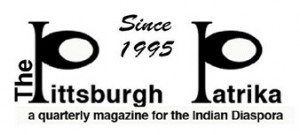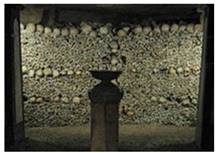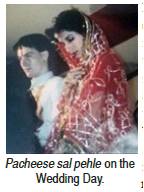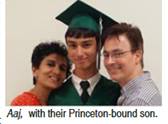Archive for October, 2015
Monopoly in Healthcare Industry not Good for Consumers or for Our Region’s Vitality
Posted by admin in October 2015 on October 23, 2015
By Kollengode S. Venkataraman
Monopoly, or even duopoly for that matter, in any industry, including the healthcare industry, in any region is bad for consumers, citizens and elected officials. Here are examples of what monopoly or near-monopoly did to our own region in the recent past:
The Rise and Fall of the Steel Industry: From the late 19th century to the past mid-20th century, the steel industry was the backbone of our region’s economy. Pittsburgh was known as the “World Capital of Steel Making.†The voluminous tome titled “Making, Shaping and Treating of Steel†published by the Pittsburgh-based U.S. Steel Co. became a bible for metallurgists, just as “Gray’s Anatomy†is for medical students. At its peak, 90,000 people worked here in the steel industry. Nearly 40% of the coal, a critical component in steel making, mined in the entire nation, was produced around the Pittsburgh region. Our football team is still called the Steelers, even decades after the industry imploded.
Naturally, the industry’s tycoons had a big influence not only on the local economy, but also on the elected officials in municipal, county, state, and even federal governments. After all, steel was critical for the defense, transportation, and canned food industries, and for roads and bridges. The steel executives pretty much did whatever they could get away with. The archives of our regional history are chockfull of details on this.
In the 1970s the American steel industry collapsed by the hubris of the industry and its trade union leaders, compounded by a pitiful failure to upgrade steelmaking technology while Japan and Europe invested heavily in making better quality steel at lower cost. The economy of our region went into a horrible tailspin. It took over 20 years — from the mid-1970s to mid-1990s — for our region to readjust and reinvent itself with new avenues in healthcare, higher education and financial services.
But the old glory days of this region were gone forever. Pittsburgh’s population plummeted from 600,000 at its peak to 300,000 today. Allegheny County’s population dropped from 1.63 million in 1960 to around 1.25 million today. Will today’s youngsters believe that only a few decades ago, Pittsburgh was the second city with the largest number of corporate headquarters, next only to New York?
With the steel industry’s rise and fall, the lesson for us is that a diversified economy is necessary to manage with less pain the unavoidable societal transitions when each segment of the economy goes through cycles of growth and decline, ultimately even death.
US Airways Flying Away from PIT: The Pittsburgh International Airport as it stands now was built in the early 1990s for the needs of US Airways, then headquartered here. At the peak of US Airways presence at PIT, we had nonstop flights to over 90 destinations (now only to 40 destinations); PIT at one point had over 600 daily departures (including to cities in Europe); US Airways accounted for over 75% of the flights. Now PIT has around 150 departures, with US Airways accounting for only over 30% of the flights. US Airways filed for bankruptcy twice and eventually shut down its hub at PIT, moving it to Philadelphia. At the peak, US Airways had over 12,000 jobs here; now it is more like 1,200.
In the heydays of US Airways’ presence at PIT, its executives had disproportionate influence not only on the airport administration, but also on our elected officials. US Airways officials never hesitated to use this for getting financial concessions, dangling the threat of moving the hub out of PIT, which they eventually did in the mid-2000s.
Granted, even in the heydays, PIT was mainly a transit airport for US Airways’ passengers for making connections to their final destinations. It took a long time for our region to realign itself to the loss of tens of thousands of air travel-related jobs as a US Airways hub. The region never really recovered from it.
This change was gut-wrenching to the airport authorities, elected officials, and to our entire region as we were transitioning from the Smoky Steel City image. Our elected officials and airport authorities are struggling to get more air carriers to PIT. It will be an uphill task.
So, we are not only intellectually, but also viscerally aware of what the choke hold of monopoly or near-monopoly does to a region. Today, as shown in the table below, the biggest employers in this region are the healthcare industry, retail, governments, higher education, and financial services. In healthcare, UPMC dominates. The University of Pittsburgh and CMU take all the limelight in education.
If you take employers with more than 2000 people on their payroll in our region today, the number of jobs (rounded off to the nearest ‘000) in different segments are as shown in the adjacent table. Source for the data: http://tinyurl.com/SW-Penna-Jobs-SnapShot Â
Large-scale manufacturing today accounts for only less than 10% of the workforce among the different segments. Of the 64,000 healthcare jobs, UPMC accounts for 43,000; University of Pittsburgh has 12,500 of the 26,000 education jobs; and 21,000 of the 48,000 retail jobs are in Giant Eagle and Walmart.
The arrogance of the officials of local monopolies and near-monopolies to flex their muscle to punish those who differ from them and muzzle their voices is so blatant that it is laughable simply for their petulance and pettiness. The fine example is UPMC, a non-profit organization with $11 billion in revenues and $11 billion in assets, not allowing the gift shops in its hospitals to sell The Pittsburgh Post-Gazette, the city’s ONLY daily. They cite “fairness issues” in the newspaper’s coverage of the very public fight between Highmark and UPMC for the lucrative healthcare industry dollars.
Steve Twedt, the Post-Gazette reporter writes, “Twice in recent years, UPMC executives canceled the health giant’s advertising in the Post-Gazette, citing dissatisfaction with the way UPMC was covered in the news pages and how it was portrayed in editorials and editorial cartoons.
Well, the purpose of cartoons is to convey messages using humor, sarcasm, irony, paradox, even ridicule, often all at the same time. If UPMC officials were bitten by the cartoons, probably there was a grain of truth in them. Maybe several grains of truth.
UPMC’s executives enjoying all the financial benefits of its non-profit status did not like the editorials/cartoons. So, they did what any monopoly business or a totalitarian regime would do: they stopped all ads in the Post-Gazette with the intention of punishing the paper. Collaterally, they also made job seekers with limited resources suffer. And then UPMC went one step even lower. It stopped its hospital gift shops from selling Pittsburgh Post-Gazette. This very cheap shot meant a couple of hundred less copies sold for the Post-Gazette, whose weekday print version has a circulation of 180,000. No big deal for the paper. In campaigns costing hundreds of thousands of dollars spent on print and audiovisual media, both UPMC and Highmark try to mould public opinion in their favor. Like political campaigns, each hyped its plus points and glossed over its negatives. The Post-Gazette, being the major daily in the town, covered the news item giving space for both sides. It could not remain without taking a stand editorially on the issue since the fight between the two was affecting the general public, and helpless healthcare consumers.
The region’s 2-million healthcare consumers, also known as sick patients, are now in the clutches of UPMC and Highmark for their critical healthcare needs, with the behemoth UPMC trying to devour Highmark to become the only game in town. No matter who wins, this fight is not in the interest of healthcare consumers, also known as patients who are sick.
UPMC’s domination in the local healthcare industry is also not good for the long-term economic vitality of our region. If you doubt this, see what the steel industry did to the Tri-State area and what US Airways did to our airport.
HOME
Swami Dayananda Saraswati (August 1930 – 23 September 2015)
Posted by admin in October 2015 on October 23, 2015
by Kollengode S Venkataraman
Swami Dayananda Saraswati, the founder of Arsha Vidya Gurukulam that is committed to educating disadvantaged children in many parts of India, and a defender of Dharma-based philosophical/religious traditions, died in Rishikesh on 23 September, 2015, after a prolonged illness. He was a disciple of Swami Chinmayananda.
Swami Dayananda made his case that proselytizing faiths such as Christianity and Islam practice spiritual violence since they start on the premise that their
approach is the only valid one in man’s spiritual quest, and all others’ approaches are false. Discerning lay persons, however, savor the irony that the three Abrahamic faiths—Judaism, Christianity and Islam, with the latter two heavily into proselytizing—have been violently disagreeing through wars and persecution on who among them is right.
While we can get the biographical details of Swami Dayananada from the Internet, one point is worth recording here.
At the turn of the millennia the United Nations invited world religious leaders to come up with a resolution on the need for people of diverse faiths to live in harmony. Leading theologians from the Abrahamic faiths (Judaism, Catholicism, Protestantism, Islam’s two branches), and others from Dharma-based schools (Teravada and Mahayana Buddhism, Jainism, Hinduism, Sikhism) joined to draft a resolution that all could agree on.
The first draft contained the term “tolerance†in the resolution. When Swami Dayananda suggested that they need to replace “tolerance†with “mutual respect†in the resolution, there was considerable opposition from Christian theologians. This is what Rajiv Malhotra writes on this (Source: http://tinyurl.com/Huff-Post-Swami-Dayananda):
Swami Dayananda Saraswati insisted that in the official draft the term toleranceâ be replaced with ‘mutual respect. Cardinal Joseph Ratzinger (who later became Pope Benedict), [leading] the Vatican delegation, strongly objected to this. After all, if religions deemed heathen were to be officially respected, there would be no justification for converting their adherents to Christianity.
The matter reached a critical stage and some serious fighting erupted. The Hindu side held firm that the time had come for the non-Abrahamic religions to be formally respected as equals at the table and not just tolerated by the Abrahamic religions. At the very last minute, the Vatican blinked and the final resolution did call for mutual respect.
However, within a month, the Vatican issued a new policy stating that while ‘followers of other religions can receive divine grace, it is also certain that objectively speaking they are in a gravely deficient situation in comparison with those who, in the Church, have the fullness of the means of salvation.’ Many liberal Christians condemned this policy, yet it remains the Vatican’s official position.â€
Given the long-established hold of the Abrahamic faiths on the world stage such as the UN, we should remember Swami Dayananda Saraswati for highlighting on the world stage the condescension and spiritual arrogance of the proselytizing religions such as Christianity and Islam towards other faiths.
♣
Book Review:Â Making Friends with Death
Posted by admin in October 2015 on October 23, 2015
Authors: Dhananjay Joshi and Arun Jatkar. Available at Amazon.com $12.00. 65 pages, 2015. Self publsihed.
Review by Kollengode S Venkataraman
A social change of great significance that has been sweeping the world is the emergence of industrialized world’s model of the nuclear family (husband-wife-children) as the basic societal building block, with support from laws, regulations, conventions, and social networking among citizens. So, in urban centers socioeconomically similar nuclear families by and large live in clusters segregated on the basis of wealth and income. We live cherishing our privacy, not realizing that privacy is a sophisticated term in good times for isolation and solitude. We realize this only when we encounter turbulences such as involuntary career transitions (aka losing jobs), financial losses, and divorces — the changes that we are often embarrassed to share with our social friends.
Or when we face unexpected healthcare issues needing 24/7 long-term care, or the death of our near and dear. Complicating this, the cost of long-term care has been soaring drawing the attention of everybody. In the US, Medicare as it exists today simply is unsustainable. Personal savings of even the “middle class†families are not enough for prolonged long-term care.
Further, long-term care for aged parents in their 80s and 90s psychologically and emotionally drains caregivers who are themselves old, often leading to a breakdown in relationships among siblings and between spouses.
Naturally, the topic of death and dying has received a lot of attention. If you Google-search under Final Exit, Death with Dignity, Compassion and Choices, Hemlock Society, and Right to Die, you will get a ton of information and advice from ethicists, psychologists, family counselors, healthcare professionals, religious scholars, and even government-funded studies. The well-known pioneer on this topic was Dr. Jack Kevorkian, the trail blazer, on whose death, we wrote this obituary: http://tinyurl.com/Patrika-Kevorkian. Dr. Kevorkian was vilified by the religious and Right-Wing conservatives. His only mistake was his in-your-face approach to draw public attention to this problem. He was also ahead of his time.
Most anglicized “educated†Indians, Hindus in particular, are uncomfortable talking about death even though as part of our ethos, we believe in impermanence and transience (anityam) and rebirth (punarjanmam). This is paradoxical and unnecessary. This is simply because only old age (jara) and death (maranam) give meaning to life. There are stories on this in Hindu puranas, Upanishads, and other texts (Yoga Vasistham). The Gita’s second chapter elucidates on this very topic. Hymns in all Indian languages constantly remind us of this. Even film songs on this topic have become popular classics. Without old age and death, life has no value, or even meaning.
In rural India, people grow up with death as part of life from childhood. Even in urban India, because of congested living, people encounter death viscerally during funeral processions. Subliminally this prepares people to face their own death, seeing it happening to someone close. This is perhaps why there was no need for a book on death and dying in India.
But Indians in North America live in their own cocoons, and are uncomfortable discussing death, and more importanly, the process of dying. This is entirely unnecessary and avoidable, and even not very smart.
For helping Indians with this topic, Dhananjay Joshi of Chicago and Arun Jatkar of Monroeville, PA, have co-authored the booklet Making Friends with Death (available with Amazon.com, $12.00). They are cousins who grew up in Pune, India in post-Independent India. The book starts with their personal encounters with death as young children and teenagers in funeral processions they saw on the street, and in deaths in their own families.
Later, Joshi arrived in the US to do his graduate studies in engineering. As he lived in a bare bone Hindu monastery in Chicago in the early days of the Indian immigrant life, Joshi even had the unique experience of performing last rites for a stranger fellow-Indian and fellow-Hindu, who died resting his head on his lap. The wife of the deceased person, who Joshi never had seen, wrote to him later: “I know I lost my husband, but I have gained a son, for which I am grateful.â€
Along the way in his journey into life, Joshi came into contact with Buddhist monks — both from Teravada and Zen schools — and learned the Buddhist ideas on transience, death, and its meditation practices. Taking care of his father-in-law in his old age till he died, Joshi saw people of Indian origin in hospice care facilities and the emptiness they felt: “They were going through the most important transition in their life, yet they had no help from one of the deeply spiritual cultures of the world.â€
With this in mind he, with Arun Jatkar, co-wrote the easily readable booklet on understanding death and how to become friends with it. They outline guided meditations to help the agitated mind to accept the inevitable, providing easy and simple readings from different cultures.
The real-life gut-wrenching stories on how people grow out of deeply held prejudices when facing death are inspiring. The authors also give simple mantras for people to recite every day to find strength from within their own inner being. Asmita Sapre Ranganathan has provided nice pencil sketches to go with the text of the booklet.
♣
My Short and Sweet Vacation in Europe
Posted by admin in October 2015 on October 23, 2015
By Cindy Koller         e-mail: ckoller@andrew.cmu.edu
Note: In the last issue of the magazine, you would have observed a few typos and other errors. That is because Cindy Koller, our copyeditor, was vacationing in Europe with her daughter. Here she shares with readers her travel experience and observations.
I went on a great adventure early June to Europe. My daughter Allison, a research specialist at the University of Pittsburgh’s Department of Emergency Medicine, was presenting a paper in a symposium at the Skane University Hospital in beautiful Lund, Sweden. And she needed a traveling companion! We took advantage of this travel opportunity and sandwiched the conference between our visits to Copenhagen, Denmark and Paris, France.
Since we were working on a budget, Allison spent hours finalizing flights, hotels, and sightseeing. Fortuitously, WOW Air, an Icelandic budget airline, had begun trans-Atlantic flights from Baltimore to Europe just in time for us. The airline flies to several European and US destinations. Through their hub in Reykjavik, we reached Copenhagen.
Copenhagen, Denmark was our first ‘adventure.’ Our hotel, the Copenhagen Star, was centrally located, a short walk from the Copenhagen Central Station and Tivoli Gardens, the famous amusement park. Summer arrives in Copenhagen only in July. So, the weather was cold, and somewhat rainy, but the people were warm and friendly.
Copenhagen is incredibly easy to see on foot and we used every minute to see all the sites. In travel across Europe, people speak of ‘ABC’s — another blasted church, another blasted castle — exactly what we were looking for.
While in Copenhagen we toured the incredible Rosenborg Castle, which houses the Danish Crown Jewels and Danish Crown Regalia; Amalienborg Palace, the winter home of the Danish Royal family; and Christiansborg Palace, the seat of the Danish Parliament; many churches and parks; the National Museum, home of the Huldremose bog woman, Danish horned helmets and the Dr. Seuss-like lur
horns. And of course, the statue of the Little Mermaid at Langelinje Pier, a popular tourist attraction.
Then, we took the train to cross the Oresund Bridge to reach the university town of Lund, Sweden. While Allison was in the conference I explored the town on foot. In the heart of town is the Lund Cathedral (Lunds Domkyrkan), a magnificent Romanesque edifice, the oldest cathedral in Scandinavia.
It houses the Astronomical Clock, which puts on a ‘show’ every day at noon and 3 pm. Two knights atop the clock mark the hour by jousting. Then, below the clock face, trumpeters raise their horns and blow a medieval fanfare and the organ
plays “In Dulci Jubilo†as the Magi emerge, parading past the Blessed Virgin and Christ Child, pausing to stop and bow their heads as they present their gifts to him.
We were in Lund on June 6, the National Day of Sweden. Most shops and stores were closed or had abbreviated hours. We were given free admission to Kulturen, an open-air museum filled with historic buildings and gardens where one can experience life in the Swedish city and countryside from the Middle Ages to the 1930s. There was a whole slate of activities to celebrate this holiday from concerts to speeches and the air was festive and fun.
Next stop: Paris, France!  After the calm, friendly and beautiful Scandinavia, we were thrust into the hustle and bustle of Paris. Alli-son had pined to visit “the City of Love†since her high school days. Our accommodations were in the heart of the Moulin Rouge, at the base of the Montmartre arrondissement. As in New York, to successfully navigate Paris one must learn to use the Metro, the local trains.
On Day 1, we thought we could accomplish all we desired to see and do on foot, and ended up walking for 14 miles in 11 hours! But we can claim to have walked the length of the Champs Elysees and seen Paris almost end to end.
Although we saw many of the “touristy†things one does in Paris – l’Arc de Triomphe, Eiffel Tower, Notre Dame Cathedral, etc. – we did have two outstanding adventures.
The first was the tour of the Catacombs that run underneath the city, reportedly the largest ossuary, or depository of human bones in Europe, housing the remains of about 6 million people. Simultaneously eerie and fascinating, we found the Catacombs one of the most interesting experiences we have ever shared.
We also had the good fortune to tour Sainte-Chappelle and experience the beauty and the brilliance of this medieval Gothic chapel. Sainte-Chappelle was built to house Louis IX’s collection of relics of Christ. The most famous features of the chapel are the fifteen 15-meter high stained glass windows depicting the biblical stories from Genesis to Revelation. With sunlight streaming through in the early afternoon, they are breathtakingly beautiful! For us, this was the highlight of the Parisian leg of our trip.
It was a whirlwind two weeks of beautiful sights and sounds. On a limited budget and with limited time we were able to see and do just enough to leave us hungry for more!
♣
Pranaam, India!
Posted by admin in October 2015 on October 23, 2015
By Jeremy Levy, Â Â e-mail:Â jlevy@pitt.edu
Jeremy Levy is the director of Pittsburgh Quantum Institute and a Distinguished Professor in the Department of Physics and Astronomy at the University of Pittsburgh. Here he reminisces about his wedding to his Indian bride, twenty-five years ago in Patna, India, and talks about some changes that have engulfed Indians in India between then and now.
Twenty-five years ago, almost to the day, my fiancée Chandralekha and I, along with my parents, brother and a few friends, stepped off of a plane in Patna, the capital city of Bihar in northern India. Days later, we were married. Our mid-June wedding coincided precisely with the arrival of the monsoon in Patna. The steady downpour wreaked havoc on the logistics of the essential marriage functions. But in India, it is a good omen for weddings. I sat on a canopy-protected stage, sipping Thums Up soda, waiting for my bride to arrive. Meanwhile, foreign bacteria marched unopposed through my intestines, setting up shop. Auto rickshaws ambled along the narrow, flooded streets of Patna, succumbing every now and then to tub-deep potholes.
Before coming to India, I knew nothing about Hindu weddings or day-to-day customs. And yet, I was anything but a tourist. There are two basic ways to greet and say farewell to someone. If it is a friend of the family or a stranger, you hold your hands, hath jhoad ke, clasping gently the two palms facing each other, and say namaste. But if it’s a relative you say pranam. And if the relative is very senior to you, you should (to be safe) do pear chew-ke pranam, an added measure of respect. Basically, you dive at their feet. It wasn’t long before I mastered the basic dive sequence. I had no idea who anyone was, so I dove at everyone: parents, grandparents, aunts, uncles, neighbors, cousins, maidservants.
That’s the mechanics of respect. But how is that really respectful? The concept of true respect quickly disintegrates when you try to pick it up and mentally isolate it. Ultimately, you just know when someone is giving you respect or not. I realized that respect isn’t really about the diving motion at all. It is a state of mind.
Twenty-five years after my own wedding, my niece Chayanika was having hers. Though it’s a Hindi movie cliché, that’s how I replay it in my mind: a shy two-year-old trash-talks as I try to push her on a swing, saying marengay (I’ll hit you). She responds: nani ke pas jayenge (I’ll go to my grandma and tell on you), and meri maa ka-han hai (where is my mother when I need her?).
cliché, that’s how I replay it in my mind: a shy two-year-old trash-talks as I try to push her on a swing, saying marengay (I’ll hit you). She responds: nani ke pas jayenge (I’ll go to my grandma and tell on you), and meri maa ka-han hai (where is my mother when I need her?).
Cut to: the beautiful bride’s arm, gracefully extended toward the mehandi wala (mehandi artist). She looks up slowly, smiles. I snap a photograph. Or rather, 30 shots each second.
One of the changes I witnessed over the past 25 years in India is the increasing encroachment of television into the daily lives of youngsters, housewives, and especially retirees. When I arrived in Patna, the family had a small black-and-white TV that received a single station — Door Darshan One. Now, large flat-screen TVs are ubiquitous among the middle and upper-middle class. They stock a quantity of channels putting the US to shame. More Hindi “soaps†are produced in India than in the US, exceeding even the Bollywood-to-Hollywood ratio of films produced annually.
In retirees’ homes, the TV is always, always, on. The main couch usually faces a flat LCD TV screen that relentlessly telecasts a soap, a news program, a Bollywood music video montage, or religious serial. When guests come, the TV stays on at full volume throughout the visit. They have become so inured to lights and sounds that people no more regard them as distractions. And of course it looks disrespectful to even get close to their remote and try to fumble with the buttons.
usually faces a flat LCD TV screen that relentlessly telecasts a soap, a news program, a Bollywood music video montage, or religious serial. When guests come, the TV stays on at full volume throughout the visit. They have become so inured to lights and sounds that people no more regard them as distractions. And of course it looks disrespectful to even get close to their remote and try to fumble with the buttons.
I Â sit on the couch that faces the big screen. The bright colorful display blinks and bleats while I mentally prepare to speak with our hosts
that faces the big screen. The bright colorful display blinks and bleats while I mentally prepare to speak with our hosts . My non-native Hindi has sputtered its way across a quarter century of stroboscopic practice. I am exposed to India like light to celluloid in a film projector. The spindle advances the frame, click. The shutter opens, allowing light to pass for all too-brief a period of time, then closes again. Time starts up again until the next frame.
. My non-native Hindi has sputtered its way across a quarter century of stroboscopic practice. I am exposed to India like light to celluloid in a film projector. The spindle advances the frame, click. The shutter opens, allowing light to pass for all too-brief a period of time, then closes again. Time starts up again until the next frame.
I sit on the couch that faces the big screen TV. Twenty slow-motion frames of Salman Khan, a convicted homicidal criminal, document his skulk from car to court house. I am forced to watch.
Mausaji, the patriarch of the family we were visiting, sits cross-legged at right angles to both me and the TV. My eyes dart toward him, to the other silently seated guests, and then come to rest on the TV. It’s a commercial for Lux, a detergent.
“Raju, take a look at this photograph.â€Â The voice is Mausaji’s.  He is not addressing me, but rather my brother-in-law, who also came from the US for the wedding. My wife’s older brother happily gets up.
I also head toward the photograph that is mounted behind me in a wooden cabinet with glass windows. The large, black-and-white photograph features a tall teenage boy towering over a pre-teen girl.
windows. The large, black-and-white photograph features a tall teenage boy towering over a pre-teen girl.
“That’s our wedding photograph, taken fifty years agoâ€, says Mausaji. He was eighteen, his bride was eleven. Right below this photograph is a second, equally large color picture. She is nearly as tall as him. He is content. She is smiling. They are both fifty years older.
I am completely, completely, transfixed by these two photographs. They sear into my memory. My eyes dart up, down, up, down, creating the most basic of all movie loops — black-and-white, color, black-and-white, color… Soft, sharp, soft, sharp… Fast-forward, rewind, fast-forward, rewind… Time compresses a billion-fold.
loops — black-and-white, color, black-and-white, color… Soft, sharp, soft, sharp… Fast-forward, rewind, fast-forward, rewind… Time compresses a billion-fold.
At some point, I snap out of my trance. What do I say to Mausaji? I carefully utter the single Hindi sentence that is looping in my mind: “Twenty five is half of fifty.â€Â It is more alliterative in Hindi: “Pachees pachaas ka adha hai.â€
Mausaji immediately catches what I was relating to. He beams, “I remember your wedding well. Ah! The pouring rain!â€
♣
Sakhi Serves South Asian Women in Distress   Â
Posted by admin in October 2015 on October 23, 2015
 By Juginder and Dolly Luthra, Weirton, PA
Editor’s note: The Luthras recently attended the Sakhi Gala in New York City. They have three daughters who grew up in Weirton and the Greater Pittsburgh area. Two of their daughters, Rashmi and Namita, living in New York City, are involved with Sakhi. Rashmi Luthra is a Board Member and Namita Luthra was the MC of the program.
As the number of immigrants from South Asia to the United States increased over the years, so did the problems faced by the women who came. Do you know that two out of five South Asian women face some sort of domestic violence — verbal, physical, emotional, or financial?
Although the problems cut across the educational and financial strata, the majority of women affected belong to first-generation, low-income women who have limited resources and are unaware of their rights. They are isolated from the local community and thousands of miles away from the families they left behind.
For addressing the problems faced by the victims, an organization, appropriately named Sakhi, was founded in 1989 in New York City by five South Asian women. Sakhi, in Sanksrit means “A Woman Friend.†Its mission is to serve the needs of victims in distress from India, Pakistan, Bangladesh, Nepal, Afghanistan, and Sri Lanka as well as South Asians from the Caribbean, and to end the violence against them. Over the years, the organization has grown in number, in its reach and financial strength. The organization helps the victims of domestic violence, with legal, emotional, educational, vocational and financial support and counseling. Scholarships are given to provide education.
The women in distress are provided with translation services by bilingual experts and access to attorneys for legal issue. Sakhi has a helpline (212 868 6741) for assistance. It has helped women in over 13,000 cases in New York City alone. However, women outside the city can and do contact Sakhi for help and guidance.
The Sakhi Economic Empowerment Program provides opportunities for survivors of domestic violence to develop job skills to obtain financial independence. The program offers computer classes and courses to start small businesses and learn their legal rights. Sakhi also reaches out to the local community to educate about domestic violence and make women aware of the services provided by Sakhi. The outreach is partly done at religious organizations. Recently, attention is also being directed to reach out to men to decrease the occurrence of abuse in the first place.
Like any other nonprofit organization, Sakhi depends on grants and donations. It was our privilege to attend the 26th Annual Gala called “Building Bridges†held in New York on April 30, 2015. The event was sold out with about 400 supporters, raising $400,000 through selling tickets for the dinner, a silent auction and seeking pledges from the audience. The program’s master of ceremonies, Namita Luthra, said, “An authentic engagement by men to end gender violence is an evolutionary step in the women’s rights movement.â€
The First Lady of New York City, Chirlane McCray, the chief guest, announced in her address her whole-hearted support for Sakhi and commended them for their effective assistance for ending domestic violence. She quipped by saying that she told the Mayor of New York City, “If he is not for she, he won’t be for me,†referring to all the women.
One of the honorees of the evening was Penny Abeywardena, New York City’s Commissioner for International Affairs. She has been involved with the global gender justice movement for a number of years. The award was presented by First Lady, Chirlane McCray. The Nayar Family was the other honoree. They helped fund the Renuka Nayar Women’s Health Initiative Fellowship in honor of their wife and mother Renuka Nayar, a long-term Sakhi volunteer who died in 2013.
The current board of Sakhi includes women from diverse backgrounds working to eradicate a human tragedy affecting the South Asian women that are victims of domestic violence.
♣
Pallavi Muluk’s Pleasant Karnatic Vocal Arangetram
Posted by admin in October 2015 on October 23, 2015
By Premlata Venkataraman
Pallavi Muluk, a disciple of Sujana Mulukutla, had her Karnatic vocal arangetram on June 27, 2015 at the Upper St. Clair High School auditorium. Pallavi’s recital was in the format of a formal concert with krtis in many languages and in different tempos.
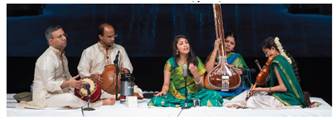 Over the years, the Indian dance arangetrams have become de rigueur for young women among Indian-Americans. Less common, though, is music arangetrams as they require years of training in shruti shuddham (voice training), layam and kaala-pramanam (complex rhythm patterns in Indian classical music), and clarity in diction in rendering Tamil, Telugu, Kannada, Sanskrit, Hindi, and Marathi krtis (lyrics).
Over the years, the Indian dance arangetrams have become de rigueur for young women among Indian-Americans. Less common, though, is music arangetrams as they require years of training in shruti shuddham (voice training), layam and kaala-pramanam (complex rhythm patterns in Indian classical music), and clarity in diction in rendering Tamil, Telugu, Kannada, Sanskrit, Hindi, and Marathi krtis (lyrics).
Pallavi’s teacher Sujana (picture below) has trained her student well in all these facets to gracefully handle the program with many pieces that included alapana, 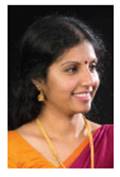 neraval and swara prastharam — all hallmarks of a confident student going on stage for the first time. Pallavi’s passion, discipline, and long hours of hard work were evident in the almost flawless solo recital.
neraval and swara prastharam — all hallmarks of a confident student going on stage for the first time. Pallavi’s passion, discipline, and long hours of hard work were evident in the almost flawless solo recital.
Her accompanying percussion artists were seasoned artistes. Jayant Balasubramanian (Mridangam) and Ravi Balasubramanian (Ghatam) are veterans. Pallavi was ably guided by these talented seniors who provided excellent structure to the concert, providing gravitas to the recital. Sushmita Ravikumar, a junior at Ohio State University, very ably provided violin accompaniment with great talent and elan. Preetha Narayanaswamy provided Tanpura support.
The encouragement and support provided for the young vocalist by the accompanying senior artistes were acknowledged by Smt. Tara Anand, the chief guest of the evening and the guru of Sujana, in her remarks.
Pallavi had requested that any gifts be in checks payable to the Chinmaya Mission. Over $8500 collected thus — which overwhelmed the Muluks — was given to the Mission.
♣
Jindal’s Madcap Pursuit for the White House
Posted by admin in October 2015 on October 23, 2015
By Kollengode S Venkataraman
In the overcrowded field of Republicans seeking nomination for the White House, 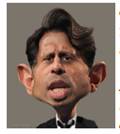 Louisiana’s Bobby Jindal became irrelevant on the very day he announced his intention in late June. I was not a fan of Jindal even when he was a rising GOP star years ago. This is what I wrote in 2010 on Jindal:
Louisiana’s Bobby Jindal became irrelevant on the very day he announced his intention in late June. I was not a fan of Jindal even when he was a rising GOP star years ago. This is what I wrote in 2010 on Jindal:
“When Jindal as governor was invited to the White House Diwali function — which has now lost all its religious significance — he did not show up. Probably because of the bad optics of the video clips filling the “very Southern†Louisiana airwaves in election commercials showing a brown Jindal in an Indian “Hindu†function in the midst of other brown Indians. That will not sit well in the deeply ‘Southern’ Louisiana… … Jindal, the Ivy league Brown University graduate in biology, in his anxiety to get elected as the governor of Louisiana, was also running away from Darwin’s Natural Selection and embraced the Judeo-Christian idea of creation in which the universe is only 6,000 years old, give or take a few centuries…â€
No sooner had Bobby Jindal announced in June seeking the GOP nomination for the White House, comments from mainstream readers were pungent and sarcastic. From the Washington Post:
“According to conservative GOPers life begins at conception. So Piyush Jindal isn’t even eligible to run for President, because he was conceived in India.†[Note: Jindal was born a few months after his pregnant mother landed in the US.]
“The mistake is thinking that being smart always translates into good policy. Plenty of smart people trade ambition and greed for good policy. Jindal is just the latest example.â€
“For laughs, I have to report that the NOLA.com’s online headline was not Jindal’s announcement but the protestors at the event—you know how bad the guy is when his own citizens will take the time to derail him… … Usually these people support … anything … coming out of the state on loyalty alone.â€
“Bobby is thankful for Mississippi; because without it, Louisiana would be dead last in just about every state ranking category.â€
From the New York Times:
“…[M]ost of us here in Louisiana are eager to enter the post-Jindal era… His has wrecked the state budget, state schools, state roads, state healthcare, and more — all to stay true to the “oath†he took not to raise taxes. Some of us are willing to pay a little more in order to have better schools, roads, healthcare, etc.; even the conservatives among us want these things and want Jindal out.â€
“A true American success story. Born of immigrant parents. Is a brilliant student. Graduates at the top of his high school class. Gets a first class education at prestigious Ivy League School. Goes on to become a Rhodes Scholar. Works at McKinsey and Co. Is soon elected Governor of Louisiana at the age of 36. This is where things go wrong… … Seems all that promise hits a brick wall when it comes down to actually doing something productive. My recommendation [for Jindal] is to go back to McKinsey and Co. where the talented Mr. Jindal is likely to only bankrupt one or two corporations rather than an entire state. This fellow seems to have peaked in high school!â€
Normally, in American electoral politics, candidates get support at least from their own ethnic groups. But Desis joined the mainstream chorus against Bobby. Here is an example from Hari Kondabolu, an Indian-American comedian in a radio network:
“Anyone got photos of Bobby Jindal eating gulab jamun or jelebi? Please release them. It may destroy his presidential campaign.â€
—     n

